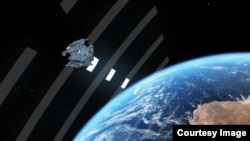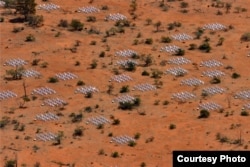Scientists in Australia are planning on listening to local FM radio stations with a very sensitive radio telescope.
No, they’re really not interested in hearing the latest song by Katy Perry or that controversial talk show that’s got people talking.
The researchers will be listening to the reflected radio waves that bounce off the tons of space junk that circles our planet in the hopes of helping to prevent possible catastrophic, multi-billion-dollar collisions in space.
So far, the researchers have been able to track FM radio waves that bounced off the International Space Station, some 400 or so kilometers from the Earth’s surface, as it passed over Western Australia.
"We have shown that we are able to detect approximately 10 pieces of space junk simultaneously. Over time this means we are in a position to monitor a significant fraction of the space junk that is in Earth orbits," said the research team leader Professor Steven Tingay, of the Murchison Widefield Array (MWA) at Curtin University and the Australian Research Council Center for All-sky Astrophysics (CAASTRO).
The idea of using reflected FM radio signals with the MWA to track space debris came from a previous study conducted by a graduate student from the Australian National University. Ben McKinley imaged the moon in 2012 by using reflected FM signals that bounced off of our orbiting satellite.
NASA says that there are over 500,000 pieces of space junk orbiting Earth. That junkyard of space debris circling Earth has been growing since the 1950s when the ‘Space Age’ first began.
Space junk can range in size from very large items such as old rocket bodies and dead satellites to very tiny particles that can even include bits of paint that were on the surfaces of various spacecraft. There’s even a screwdriver which slipped from an astronaut's hand during a spacewalk to do some repair work.
Some of that space debris, especially those that are in low-Earth orbit, fall back to the planet, and much of it burns up during re-entry.
But the dangers of collisions with space junk are quite real with hundreds of the satellites we’ve come to depend on in serious jeopardy. Even a two-millimeter fleck of paint zooming at speeds of between seven to eight kilometers per second, can seriously harm or possibly kill space travelers or destroy a billion-dollar communications satellite.
While major collisions between large pieces of space debris are rare such incidents have happened. Back in Feb. 10, 2009, two large satellites, the Iridium 33 and the Kosmos 2251, collided at a speed of about 42,000 kilometers per hour. The collision spread about 1,000 pieces of debris capable of being tracked across the skies, where much of it remains.
To avoid harm from potentially dangerous space debris, the International Space Station conducts a number of collision avoidance maneuvers each year.
"An early warning system has the potential to protect the billions of dollars’ worth of vital infrastructure orbiting the earth but also prevent collisions that will result in even more space debris being generated…” said Tingay.
This new space junk detection and tracking effort from Australia joins other programs like those run by space agencies such as NASA and ESA.
No, they’re really not interested in hearing the latest song by Katy Perry or that controversial talk show that’s got people talking.
The researchers will be listening to the reflected radio waves that bounce off the tons of space junk that circles our planet in the hopes of helping to prevent possible catastrophic, multi-billion-dollar collisions in space.
So far, the researchers have been able to track FM radio waves that bounced off the International Space Station, some 400 or so kilometers from the Earth’s surface, as it passed over Western Australia.
"We have shown that we are able to detect approximately 10 pieces of space junk simultaneously. Over time this means we are in a position to monitor a significant fraction of the space junk that is in Earth orbits," said the research team leader Professor Steven Tingay, of the Murchison Widefield Array (MWA) at Curtin University and the Australian Research Council Center for All-sky Astrophysics (CAASTRO).
The idea of using reflected FM radio signals with the MWA to track space debris came from a previous study conducted by a graduate student from the Australian National University. Ben McKinley imaged the moon in 2012 by using reflected FM signals that bounced off of our orbiting satellite.
NASA says that there are over 500,000 pieces of space junk orbiting Earth. That junkyard of space debris circling Earth has been growing since the 1950s when the ‘Space Age’ first began.
Space junk can range in size from very large items such as old rocket bodies and dead satellites to very tiny particles that can even include bits of paint that were on the surfaces of various spacecraft. There’s even a screwdriver which slipped from an astronaut's hand during a spacewalk to do some repair work.
Some of that space debris, especially those that are in low-Earth orbit, fall back to the planet, and much of it burns up during re-entry.
But the dangers of collisions with space junk are quite real with hundreds of the satellites we’ve come to depend on in serious jeopardy. Even a two-millimeter fleck of paint zooming at speeds of between seven to eight kilometers per second, can seriously harm or possibly kill space travelers or destroy a billion-dollar communications satellite.
While major collisions between large pieces of space debris are rare such incidents have happened. Back in Feb. 10, 2009, two large satellites, the Iridium 33 and the Kosmos 2251, collided at a speed of about 42,000 kilometers per hour. The collision spread about 1,000 pieces of debris capable of being tracked across the skies, where much of it remains.
To avoid harm from potentially dangerous space debris, the International Space Station conducts a number of collision avoidance maneuvers each year.
"An early warning system has the potential to protect the billions of dollars’ worth of vital infrastructure orbiting the earth but also prevent collisions that will result in even more space debris being generated…” said Tingay.
This new space junk detection and tracking effort from Australia joins other programs like those run by space agencies such as NASA and ESA.










